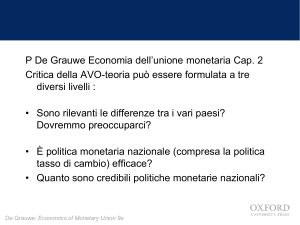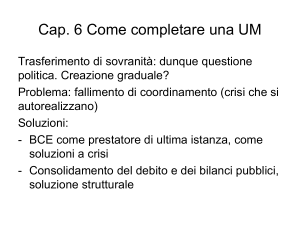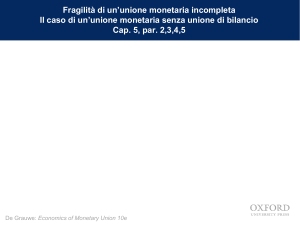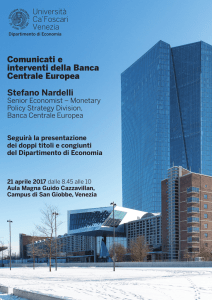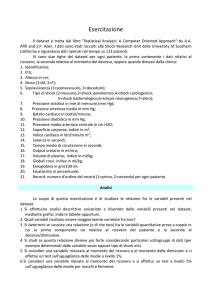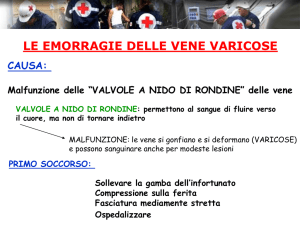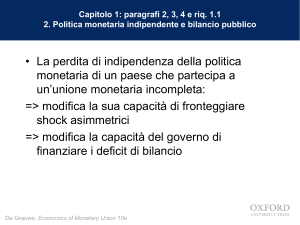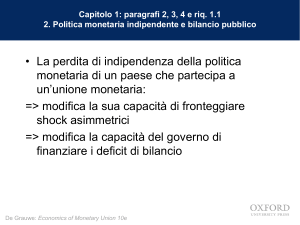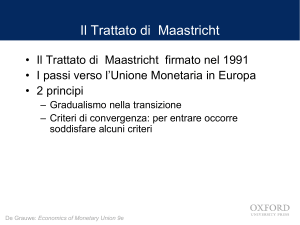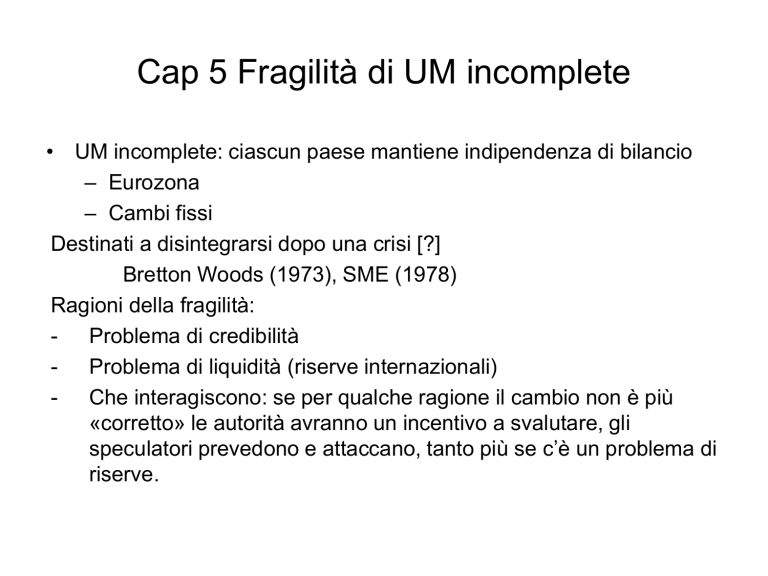
Cap 5 Fragilità di UM incomplete
• UM incomplete: ciascun paese mantiene indipendenza di bilancio
– Eurozona
– Cambi fissi
Destinati a disintegrarsi dopo una crisi [?]
Bretton Woods (1973), SME (1978)
Ragioni della fragilità:
- Problema di credibilità
- Problema di liquidità (riserve internazionali)
- Che interagiscono: se per qualche ragione il cambio non è più
«corretto» le autorità avranno un incentivo a svalutare, gli
speculatori prevedono e attaccano, tanto più se c’è un problema di
riserve.
Modello
• Disavanzo dei conti con l’estero
aumento l’indebitamento con l’estero
• Prima o poi deve essere corretto
• Due modi:
– Riduzione della domanda interna (costoso
politicamente)
– Svalutazione (si assume meno costoso)
Costi e benefici di una svalutazione:
modelli di prima generazione
Costi e benefici di una svalutazione:
modelli di prima generazione
• Se ε > ε0 cioè se lo shock è grande, il beneficio della
svalutazione supera il costo, ci sarà dunque la
tentazione di svalutare,
• La speculazione prevede la mossa,
attacca precipitando la svalutazione
La ragione della crisi sta nel tentativo delle autorità di
perseguire obiettivi inconciliabili.
La speculazione accelera semplicemente quello che
dovrebbe accadere [ma può anche far accadere quello che
avrebbe potuto essere evitato]
Modelli di seconda generazione: equilibri
multipli
• Distinzione fra svalutazione attesa e inattesa
• BU-curve : benefit of devaluation when
devaluation is not expected
• BE-curve : benefit of devaluation when
devaluation is expected (=speculative attack)
• BE > BU because when devaluation is expected
the defence of the fixed rate is very costly
(central bank has to raise interest rate with
negative effect on economy)
Tre shocks
• a small shock: ε < ε1 ;
– no devaluation because the cost exceeds the
benefits
– Speculators know this
– They do not expect devaluation
– Expectations consistent with outcome of
model
– Fixed exchange rate credible
• large shock ε > ε2
– devaluation is certain
– because the benefits exceed the cost.
– the fixed exchange rate is not credible
– expectations are model consistent
• intermediate shock: ε1<ε < ε2.
– Two possible equilibria, N and D
– In N: speculators do not expect devaluation;
as a result cost > benefit; no devaluation
occurs
– In D: speculators expect devaluation; as a
result cost < benefit; devaluation occurs
– The selection of these two equilibria only
depends on state of expectations
– Self-fulfilling prophecy: It is sufficient to expect
a devaluation for this devaluation to occur.
Nota Importante
• The existence of two equilibria ultimately depends on the
fact that the central bank has a limited stock of
international reserves. [o libertà di movimento di capitali]
• Suppose the central bank had an unlimited stock of
international reserves.
• In that case, when a speculative attack occurs
(speculators expect a devaluation), the central bank
would always be able to counter the speculators by
selling an unlimited amount of foreign exchange.
• The central bank would always beat the
speculators.
• The latter would know this and would not
start a speculative attack.
• In other words they would not expect
devaluation.
• The BE curve would coincide with the BUcurve.
• There would be no scope for multiple
equilibria.
• Ruolo dei movimenti di capitali
• Currency board
UM senza unione fiscale
• UM incompleta:
• Un’autorità monetaria (BCE) e autorità
nazionali indipendenti (che fissano bilancio
e debito)
• Il debito è emesso in una moneta che non
possono controllare
• La speculazione passa dal cambio ai
titoli del debito pubblico
Modello semplice
• Costi e benefici del default
• Gli investitori lo sanno
• Shock: riduzione delle entrate (es.
recessione o perdita di competitività)
• De Grauwe lo definisce uno shock di
solvibilità
Benefits of default
Figure 5.3 The benefits of default after a solvency shock.
benefits
• Benefit of default:
• Government reduces
interest burden;
• Cost of taxation
reduced
• Benefit increases with
size of solvency shock
• And size of govt debt
Solvency shock
Cost and benefit of default
Figure 5.4 Cost and benefits of default after a solvency shock
Cost arises because of loss of reputation and thus difficulties
to borrow in the future
Three types of shocks
Figure 5.5 Good and bad equilibria
Small shock: S < S1
There will be no default because
cost exceeds benefits,
Consistent with expectations
Large shock: S > S2.
Default is certain because benefits
exceed costs
Consistent with expectations
Intermediate shock:
S1 < S < S 2
Two equilibria: N and D
Both consistent with expectations
De Grauwe: Economics of Monetary Union 9e
Equilibri multipli
• Per valori dello shock intermedi, possiamo avere
due risultati (D o N)
• The selection of one of these two points only
depends on what investors expect.
– If the latter expect a default, there will be one;
– if they do not expect a default there will be none.
– This remarkable result is due to the self-fulfilling nature of
expectations.
• We have coordination failure
Se il risultato è default
• Crisi bancaria
• Fuga dai titoli i aumenta e i P cadono
perdite in c/K delle banche
• Si interrompe il flusso del credito: problemi di
finanziamento delle banche (la liquidità
scompare)
• La crisi del debito si trasforma in crisi bancaria
Gli stabilizzatori automatici vengono
neutralizzati
• La recessione (e la crisi) aumenta il disavanzo
speculazione contro i titoli necessità di politiche di
austerità in recessione
• Stesso meccanismo dei PVS: impossibilità di usare il
bilancio pubblico per stabilizzare il ciclo (aggravando il
ciclo)
• Fuori da UM il governo può contare sulla BC, da questo
dipende la possibilità di due equilibri
Case study: From liquidity crises to
forced austerity in the Eurozone
• Two topics
• Empirical evidence: strong increases in the
government bond spreads in the Eurozone
since 2010 :
– were not only due to deteriorating fundamentals (e.g.
government budget deficits and debt levels)
– but were driven mainly by market sentiments (i.e. by
panic and fear).
• The ensuing spreads forced countries into
severe austerity measures that in turn led to
increasing government debt to GDP ratios.
De Grauwe: Economics of Monetary Union 9e
Positive relation between Government debt and spreads
But sudden burst from 2010 that cannot be explained by increase in debt
De Grauwe: Economics of Monetary Union 9e
Estimated from econometric equation linking spreads with whole series of
fundamental variables
Time component is proxy for market sentiments (fear and panic)
Greece: mostly fundamentals’ driven; other countries: mostly market sentiments
De Grauwe: Economics of Monetary Union 9e
• How did the surge in the spreads that (as we
showed) were mostly related to market
sentiments affect the real economy?
• This is the question of how these spreads and
the ensuing liquidity problems forced the
governments of these countries into austerity
Figure 5.8 Austerity measures and spreads in 2011.
De Grauwe: Economics of Monetary Union 9e
Interpretation
• Increasing spreads due to market panic,
these increases gripped policy makers.
• Panic in the financial markets led to panic in
the world of policymakers in Europe.
• As a result of this panic, rapid and intense
austerity measures were imposed on
countries experiencing these increases in
spreads.
• How well did this panic-induced austerity
work?
De Grauwe: Economics of Monetary Union 9e
Figure 5.9 Austerity (2011) and GDP growth (2011–12).
De Grauwe: Economics of Monetary Union 9e
Figure 5.10 Austerity (2011) and increases in government
debt–GDP ratios (2010IV–2012III).
De Grauwe: Economics of Monetary Union 9e
Conclusion
• In this chapter we have analyzed the inherent
fragility of incomplete monetary unions.
• We focused on two incomplete monetary unions,
– i.e. a fixed exchange rate regime and
– a Eurozone-type incomplete monetary union.
• Both types of unions are characterized by a similar
fragility.
• In both cases, a lack of confidence can in a selffulfilling way drive the country to a devaluation (in
the first case) or to a default (in the second case.
De Grauwe: Economics of Monetary Union 9e
• fragility is problematic because it leads to
questions of sustainability of incomplete
monetary unions.
De Grauwe: Economics of Monetary Union 9e
Crisi autorealizzantesi
•
•
•
•
•
Crisi di credibilità
aumento spreads
Austerità
Riduzione crescita del PIL
Aumento debito/PIL
Come rendere la UM sostenibile?
– Accrescere i costi dell’insolvenza (espulsione dei
paesi inadempienti)
– Prestatore di ultima istanza della BCE
– Consolidare i debiti nazionali in un unico debito
comune
• Come eliminare il circolo vizioso debito
sovrano-banche?
– Unione bancaria: ripartisce su tutti la crisi di un paese
Grexit
• La bolla?
– Tasso di crescita del PIL sostenuto
– Debito pubblico/PIL non si riduce
– Indebitamento pubblico e privato (credit push)
– Differenziale di inflazione (CLUP relativi)
• La crisi
– Sudden stop: rientro dei capitali bancari
– Crisi del debito sovrano e delle banche:
condizionalità dei prestiti
– Austerità, de-levereging, svalutazione interna:
caduta del reddito e aumento debito/PIL
Costi e benefici della Grexit
• Grecia:
– default sul debito, con implicazioni sulla solvibilità del sistema
bancario (e sui risparmi privati e istituzioni previdenziali)
– Svalutazione: aumento di competitività ma rischi di spirale
inflazionistica
• Resto dell’UME
– Rischio contagio e credibilità: al prossimo shock, chiunque può
uscire
– Riduzione dell’esposizione netta delle imprese verso altri paesi,
per timore di potenziali perdite in caso di uscita e
ridenominazione in valuta nazionale
•
L’uscita renderebbe il resto dei paesi con una struttura
più uniforme, migliorando la convergenza?

